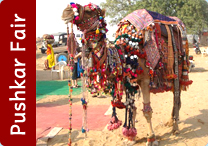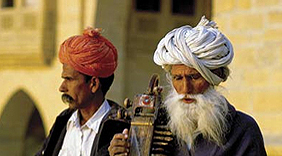
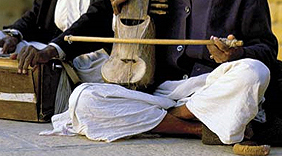

Custom Made Tour
Feel free to let us know if you are looking for customize tour program as all the tour itinerary is sample it can be modify according to your requirements.
Home - Rajasthan Forts and Palaces - City Palace, Udaipur
City Palace, Udaipur
City Palace, Udaipur
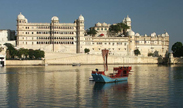
City Palace towers over the Pichola Lake. Maharana Uday Singh initiated the construction of the palace but succeeding Maharanas added several palaces and structures to the complex, retaining the uniformity of design. The entry to the palace is from the Hati Pol, the Elephant gate. The Bari Pol or the big gate brings one to the Tripolia, the Triple gate. It was once a custom that the Maharana would weigh under this gate in gold and silver, which was distributed to the populace. Now, it's the main ticket office. Balconies, cupolas and towers surmount the palace to give a wonderful view of the lake. Suraj Gokhada or the 'Balcony of Sun' is where the Maharana used to grant public audiences, mainly to boost the morale of the people in difficult times. The Mor Chawk is the peacock square and gains its name from the vivid blue mosaic in glass of a peacock that decorates its walls.
 The main part of the palace is now preserved as a museum displaying a large and diverse array of artefacts. The City Palace museum is entered through the Ganesh Deori meaning the door of Lord Ganesh. This leads to the Rajya Angan, the royal courtyard which is the very spot where Maharana Udai Singh met the sage who told him to found a city here. An armoury museum exhibits a huge collection of protective gear and weapons including the lethal two-pronged sword. The rooms of the palace are superbly decorated with mirrors, tiles and paintings. Manak Mahal or the Ruby palace has a lovely collection of glass and mirror work while Krishna Vilas display a rich collection of miniature paintings. Moti Mahal or the Pearl palace has beautiful mirror work and the Chini Mahal has ornamental tiles all over. The Surya Chopar or the Sun Square depicts a huge ornamental sun symbolising the sun dynasty to which the Mewar dynasty belongs. The Bari Mahal is a central garden with a magnificent view of the city. Some more beautiful paintings can be seen in the Zenana Mahal or the ladies chamber, which leads to Lakshmi Chowk, a beautiful white pavilion.
The main part of the palace is now preserved as a museum displaying a large and diverse array of artefacts. The City Palace museum is entered through the Ganesh Deori meaning the door of Lord Ganesh. This leads to the Rajya Angan, the royal courtyard which is the very spot where Maharana Udai Singh met the sage who told him to found a city here. An armoury museum exhibits a huge collection of protective gear and weapons including the lethal two-pronged sword. The rooms of the palace are superbly decorated with mirrors, tiles and paintings. Manak Mahal or the Ruby palace has a lovely collection of glass and mirror work while Krishna Vilas display a rich collection of miniature paintings. Moti Mahal or the Pearl palace has beautiful mirror work and the Chini Mahal has ornamental tiles all over. The Surya Chopar or the Sun Square depicts a huge ornamental sun symbolising the sun dynasty to which the Mewar dynasty belongs. The Bari Mahal is a central garden with a magnificent view of the city. Some more beautiful paintings can be seen in the Zenana Mahal or the ladies chamber, which leads to Lakshmi Chowk, a beautiful white pavilion.Inside the separate palace enclosure, entered from the south of Badi Chowk, are the Shiv Niwas and Fateh Prakash Palace, which are now run as hotels. The grand City Palace on the banks of Pichola Lake is the finest example of architectural and cultural explosion under the rule of Rajput rulers. The palace hails tourists from all over the world, leaving them awestruck by its beauty and grandeur.
Legend
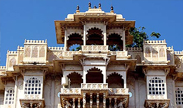
Visitors Information
The city palace is accessed from Udaipur city, which is well connected by road, rail and air links with the rest of the country.The city lies on the Golden Quadrilateral, midway between Delhi and Mumbai National Highway (NH) 8; it is about700 kilometres (430 mi), from either metro. The East West Corridor, which starts from Porbandar and ends at Silchar, passes and intersects the Golden Quadrilateral and shares the common space from Udaipur to Chittor.
Train connectivity is established between Delhi, Jaipur and Ahmedabad through trains run by Indian Railway. Udaipur is connected with Delhi, Kota and Mathura with the "Mewar Express" on broad gauge tracks. Udaipur is connected with Kolkatta, by the "Ananya Express". A train has also been introduced between Mumbai and Udaipur via Vadodara, Ratlam and Chittorgarh.
 Dabok airport, also known as Maharana Pratap Airport, is 24 kilometres (15 mi) from the city centre. Daily flights connect Udaipur with Jodhpur, Jaipur, Aurangabad, Mumbai and Delhi. The airport is proposed as an International airport by 2011.
Dabok airport, also known as Maharana Pratap Airport, is 24 kilometres (15 mi) from the city centre. Daily flights connect Udaipur with Jodhpur, Jaipur, Aurangabad, Mumbai and Delhi. The airport is proposed as an International airport by 2011.The city Place has transport facilities of unmetered taxis, auto rickshaws, tongas, city bus, and regular city bus service is available from Udaipur City to the Dabok Airport, Badi Lake, and Bedala.


